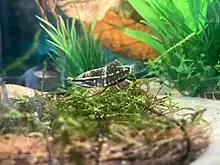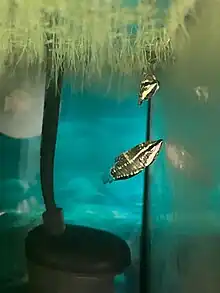| Sphaerichthys vaillanti | |
|---|---|
.jpg.webp) | |
| Female (front); Male (back); | |
| Scientific classification | |
| Domain: | Eukaryota |
| Kingdom: | Animalia |
| Phylum: | Chordata |
| Class: | Actinopterygii |
| Order: | Anabantiformes |
| Family: | Osphronemidae |
| Genus: | Sphaerichthys |
| Species: | S. vaillanti |
| Binomial name | |
| Sphaerichthys vaillanti Pellegrin, 1930 | |
Sphaerichthys vaillanti, known as Vaillant's chocolate gourami, Samurai gourami, or Samurai zebra gourami ,[1] is a species of gourami. It is native to Asia, where it is known from mainly the Kapuas river in the Semitau Kalimantan region of Borneo in Indonesia. It is generally seen in pairs in small creeks or drainage where wood debris is abundant. It is known to mimic dead leaves as a form of camouflage. The species reaches about 6 cm (2.5 inches) in standard length and is known to be a facultative air-breather.[2]
Taxonomy
This species descends from the ray-finned fishes, infraclass Telostei, clade Percomorpha, and order Anabantiformes. It is an anabantoid from the family Osphronemidae and subfamily of Luciocephalinae. It is from the genus Sphaerichthys and finally species Vaillanti.
Discovery and History
This species was discovered and described by Leon Vaillant, who mistakenly first thought of it as a Frail gourami (Ctenops nobilis).
It was then named after Leon by Jacques Pellegrin for discovering the new species. The year of its description is 1832.
Life Cycle
Unlike many other fish species, the female of these mouthbrooders actually initiates the courting behavior, and during this time, they will remain upright for many hours during reproduction. The female will then lay the eggs, about 10-40, and the male will gather them in his mouth. He will then hide while the female guards the area to protect the eggs.
Description
The male and female of this species have great sexual dimorphism as the females are brightly colored red with a predominant green and dark vertical stripes. The males are much simpler with a dull reddish brown with a few vertical and horizontal white lines. Juveniles are brown with clear caudal tails and white markings throughout. All of the coloring that these anabantoids have are to resemble the dead leaf litter and debris that is found naturally in their environment.
Threats
This species is threatened in many ways in that it is an endemic species to Borneo. It is very sought after in the aquarium trade, making it vulnerable to going extinct due to mass collection. Habitat destruction and pollution from illegal gold mining also threaten this gourami, as it was hard to find and rare in the first place with its camouflage.
In the Aquarium

This species is rarely seen in the aquarium trade, and is usually stocked from specialist breeders.

When found, it usually requires a 10+ gallon aquarium that has a PH of 3.5-6.8, and is decorated with wood, botanicals, a sandy substrate, and tannin stained water. It needs soft and acidic water along with little flow which replicates its habitat. It is an omnivore eating plant and algae matter along with small creatures such as daphnia and worms. The fry can use the diatoms from the decay of plant matter as a secondary food source.
Gallery
.jpg.webp) Adult S. Vaillanti pair
Adult S. Vaillanti pair Aerial view of Kapuas river
Aerial view of Kapuas river.jpg.webp)
 Kapuas River Location
Kapuas River Location Camouflage of Samurai Gourami in habitat
Camouflage of Samurai Gourami in habitat Riverbed habitat
Riverbed habitat A pair near a cryptocoryne
A pair near a cryptocoryne Specimen behind Java moss
Specimen behind Java moss Samurai gourami in aquarium
Samurai gourami in aquarium Specimen near corner surface of aquarium
Specimen near corner surface of aquarium Pair underneath cryptocoryne
Pair underneath cryptocoryne
References
- ↑ "Sphaerichthys vaillanti – Vaillant's Chocolate Gourami — Seriously Fish". Retrieved 2023-02-13.
- ↑ Froese, Rainer; Pauly, Daniel, eds. (2023). "Sphaerichthys vaillanti". FishBase.
3. https://aquadiction.world/species-spotlight/samurai-gourami/. Retrieved 2023-9-23
